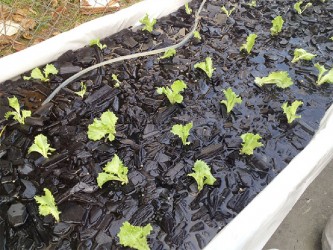By Mark Jacobs
These are exciting times for the science of farming. Unpredictable weather patterns resulting from climate change and scarcity of arable land coupled with dire warnings of an impending global food crisis compel individuals, communities and countries to re-evaluate their agricultural practices and techniques in an effort to maximise food production as much for export as for their own self-sufficiency.
The farming technique known as aquaponics has caught my attention for several reasons, mostly because it is an efficient, economical and environmentally friendly approach to producing food. More than that and in an odd sort of way, aquaponics might have its appeal even amongst people who have never considered themselves farmers. It can be a considerable ‘turn on’ for innovators.
My own family background is in farming. Both my father and my uncle are farmers and I have agreed to share some of my own thoughts on the sector through the pages of this newspaper. For the moment, however, I make the point about farming being in my family solely to emphasise that I have not arrived at the juncture of writing about farming with a complete lack of understanding of the discipline.

Aquaponics first caught my attention a few years ago and I began reading and researching on the subject. Those pursuits led me to visit aquaponic facilities in New York, Haiti and Florida. I became sufficiently interested in the discipline to set up a crude manual aquaponic system in a rooftop garden in Port au Prince where I had been living and working with Haitians on various projects that had to do with finding ways to maximise food production.
My plants did fairly well until my fishes began to die because I was not circulating and aerating my tank properly. After all my fishes were gone I decided to work backward and I eventually figured it out.
I went back to the drawing board, reading and researching. Once I returned to Guyana I designed a system that now works for me. What I have discovered is that the key to a successful aquaponics project lies in utilising local materials rather than importing expensive equipment. My existing prototype combines a mixture of ebb and flow and vertical tubes connected to a fish tank buried underground. Everything had to be designed from scratch – so to speak. I was not working from any pre-determined plan. Since I was untrained in some areas critical to the execution of the project I sought and secured the help of family members who were more versed in such pursuits.
But lest I get ahead of myself I should, at this juncture, say what aquaponics is. It is a method of farming that employs fish waste and waste left behind by other aquatic life forms to fertilize plants in what can be described as a closed system. In a remarkable relationship of mutual dependence the fish waste provides the nutrients to feed the plants whilst the plants ensure the survival of the fish by purifying the water.
There are various types of aquaponic systems. In what is known as the re-circulating system plants are grown in beds comprising media that include pellets, rocks, charcoal and synthetic plastics. Water from the aquaculture system is used to flood the bed and nourish the plants after which the purified water flows back into the fish tanks.
In the deep water culture, the plant roots are suspended in the nutrient rich solution. The plants are usually supported by a floatation system comprising Styrofoam. This is the most commonly used system of aquaponics, particularly in commercial agriculture.
Experimentation has thrown up various other approaches to the application of aquaponics. Some of these utilise contraptions comprising half drums (galvanized drums cut in half), PVC pipes and buckets that allow for a continual flow of water.
Each system has its benefits, depending on the scale and purpose of the project. The deep water method is the recommended approach for commercial farming.
The history of aquaponics
The floating gardens in the lakes of the Valley of Mexico is one of the earliest known examples of aquaponics. However, aquaponics has been practiced in Asian countries like China, Indonesia and Thailand for centuries.
There the practice manifests itself in the simultaneous cultivation of rice and fish. Asian farming practices have also seen the rearing of eel and snails utilizing the aquaponic method.
Current developments in aquaponics began in Massachusetts at the New Alchemy Institute on Cape Cod. A group of Americans created a 12-acre farm with the aim of re-evaluating and redesigning the entire human food system into an ecologically driven one.
The most commonly used fish in aquaponic systems is the tilapia. However, silver perch, crayfish, eel-tailed catfish, perch, cod, prawns, koi and gold fish are also used. The fish used will be based on geographic location and availability.
The contraption of vertical tubes comprising my own aquaponics experiment was designed and fabricated in the kitchen. I gave my ideas for a grow bed to a cousin who fabricated the frame and I took it from there. The growing medium in my prototype is charcoal and I am currently growing lettuce, kale, Swiss chard, turmeric, tomato and calaloo.
The system has an electronic control mechanism that monitors and adjusts water levels and air into the fish tank. Part of my preoccupation is with ensuring that I do not repeat the mistakes which I made in Haiti.
The benefits to be derived from employing aquaponics in food production include the removal of the need for commercial fertiliser or chemicals; higher yield from smaller space; the eradication of water wastage; eradication of the need to dispose of waste; all year round production that is not dependent on the vagaries of the weather; and removal of necessity for land clearing. Most if not all of these considerations are relevant in the Guyana farming context.





